|
|
|
Sort Order |
|
|
|
Items / Page
|
|
|
|
|
|
|
| Srl | Item |
| 1 |
ID:
108149
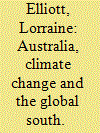

|
|
|
|
|
| Publication |
2011.
|
| Summary/Abstract |
Australia's climate change relationship with developing countries is framed by the 1992 United Nations Framework Convention on Climate Change and the 1997 Kyoto Protocol. Under those agreements, Australia has committed to take a lead in cutting greenhouse gas emissions and to provide technological and financial support to developing countries. In practice, Australian governments of both political hues have adopted a somewhat ambiguous and ambivalent attitude to developing countries within climate change politics and their fulfilment of those commitments has been uneven. This is particularly so if the concept of the 'Global South' is expanded from developing countries to include those people who are vulnerable to the environmental, social and economic impacts of climate change.
|
|
|
|
|
|
|
|
|
|
|
|
|
|
|
|
| 2 |
ID:
115193
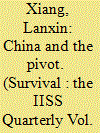

|
|
|
|
|
| Publication |
2012.
|
| Summary/Abstract |
The Obama administration seems to have toned down its rhetoric on Asia-Pacific security, abandoning the fancy but problematic phrase 'pivot towards Asia' and replacing it with the more prosaic 'rebalancing'. This does not mean the content of US policy is very different. On the contrary, the Obama administration continues its military build-up in the region, aiming at a military posture that can only be described as 'absolute superiority'. Over the past two years, Washington has put together a comprehensive 'containment' package in Asia that includes a new military doctrine of air-sea battle; launched a game-changing economic project called the Trans-Pacific Partnership; initiated the 'rotation' of US marines in Australia; and stationed coastal battleships in Singapore. More alarmingly, the United States is making clear attempts to re-establish a naval presence in Subic Bay in the Philippines, and in the coveted Cam Ranh Bay in Vietnam. Both were key US naval bases during the Cold War.
|
|
|
|
|
|
|
|
|
|
|
|
|
|
|
|
| 3 |
ID:
120203
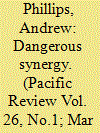

|
|
|
|
|
| Publication |
2013.
|
| Summary/Abstract |
This paper analyzes the current and prospective implications of Asia's energy consumption revolution for regional stability. Adopting a comparative and historical approach, I argue that Japanese energy security anxieties worked to reinforce regional alignment patterns in East Asia for nearly two decades following the Shanghai communiqué, thereby strengthening regional stability. Conversely, the post-Cold War period has seen in China and India's rise the emergence of Asian energy super-consumers that are not formally aligned with the United States, but that are increasingly dependent on imported energy supplies to fuel their industrialization. This newfound dependence on energy imports has seen both countries follow Japan's longstanding example in securitizing energy as a policy issue. In the context of an already more contested Asia, this trend towards energy securitization has aggravated regional tensions and will continue to do so unless greater efforts are undertaken bilaterally, regionally and globally to foster more effective forms of energy cooperation.
|
|
|
|
|
|
|
|
|
|
|
|
|
|
|
|
| 4 |
ID:
112744


|
|
|
|
|
| Publication |
2012.
|
| Summary/Abstract |
This article surveys some of the challenges that President Obama or his successor
will face over the next several years as the United States attempts to "pivot
toward Asia." In view of the ongoing shift in power from West to East, Washington
can no longer assume that it can preserve or transform Asia-Pacific security by its
unilateral actions. Rather, the United States must develop a "lead from behind"
strategy that will assist America's Asia-Pacific friends and allies to "make room
for China" while at the same time encouraging them to take greater responsibility
for regional security. As it develops its plans for the Asia-Pacific region, the
United States will have to accord special attention to three legacy issues (the
China-Taiwan relationship, the unresolved confrontation between North and
South Korea, and the incompatibility of American and Chinese values) which
have confounded U.S.-China relations for six decades. If managed properly, a
U.S. pivot toward Asia can be beneficial to both the United States and America's
regional friends and allies. But this will require Washington to pursue what President
Obama recently described as a "more centered course" that leverages America's
assets in the Asia-Pacific while avoiding policies that force regional governments
to choose between Washington and Beijing.
|
|
|
|
|
|
|
|
|
|
|
|
|
|
|
|
| 5 |
ID:
138098
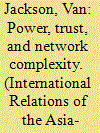

|
|
|
|
|
| Summary/Abstract |
Why do hedging strategies appear so pervasive in Asia? This article argues that hedging – not balancing or bandwagoning – is the central tendency in Asian international relations, offering three different lenses for making sense of this phenomenon, focusing in particular on the third: power transition theory, mistrust under multipolarity, and complex networks. Each perspective highlights different factors that explain the incentives for Asian states to hedge, what hedging looks like, and how long hedging is likely to endure. Power transition theory tells us that hedging is the result of uncertainty about a possible power transition between the United States and China. Multipolarity points us to uncertainty about the intentions of a growing number of states. And the logic of complex networks explains hedging as a response to the topology of Asia’s complex network structure – consisting of sensitivity, fluidity, and heterarchy – which makes it difficult for Asian-foreign policy elites to assess the future consequences of present day commitments.
|
|
|
|
|
|
|
|
|
|
|
|
|
|
|
|
| 6 |
ID:
118893
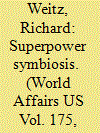

|
|
|
| 7 |
ID:
047446
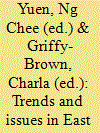

|
|
|
|
|
| Publication |
Tokyo, International Development Research Institute, 2000.
|
| Description |
xi, 348p.
|
|
|
|
|
|
|
|
|
|
|
|
Copies: C:1/I:0,R:0,Q:0
Circulation
| Accession# | Call# | Current Location | Status | Policy | Location |
| 043386 | 330.95/YUE 043386 | Main | On Shelf | General | |
|
|
|
|
|
|
|
|
|